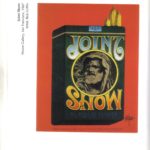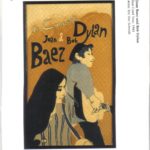Price and stock to confirme
Ed. Abbeville Press, 1987. Size 11,5 x 10 cm. It includes more than 250 poster reproductions in color. State: Used, very good. 347 pages
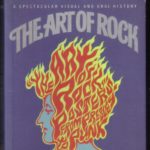 A plague of crazed critics, curators, and graduate students will descend upon me if I declare that rock posters are great modern art. So what I’ll tell you is that they inspire extraordinary love and passion and that, unlike most other modern artworks, they are truly popular: thousands of people all around the world now avidly collect them.
A plague of crazed critics, curators, and graduate students will descend upon me if I declare that rock posters are great modern art. So what I’ll tell you is that they inspire extraordinary love and passion and that, unlike most other modern artworks, they are truly popular: thousands of people all around the world now avidly collect them.
Many of the posters are exceptional graphic achievements: their printing employs the highest skills, and the poster artists themselves have extended the limits of their medium. These artists and printers were innovators bent on bringing forth something manifestly new and exciting.
Rock posters have been around as long as rock music has— about thirty-five years. Not since Europe of the 1930s has poster art played so significant a role in promoting popular entertainment. Moreover, rock posters have become a leading popular art form that has greatly influenced such related graphic fields as advertising. Rock art is tied directly to the changing music of a thirty-five-year period; simply put, because there are rock concerts, there are inevitably rock posters. It is also true that rock music has reflected, even as it has helped to shape, its thirty-five-year span of American and international culture. And so the posters are a visual hístory not only of the music but also of a bit of the world that produced the music.
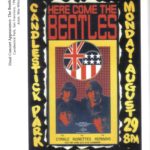 Rock has many roots and branches, and what this book calls rock poster art also embraces other forms of popular music related to rock. Black music had an obvious and great effect, as did country. The posters help to tell how and why this is so. The book begins in the mid-1950s, when rock was very young and when for the most part black people were still setting the popular music trends followed by various white performers. By 1955, swing-jazz, jump bands, and early rhythm and blues had yielded to the likes of James Brown and, a little later, Elvis Presley. With the sixties came the Temptations and Aretha Franklin, then Bob Dylan, and the stprming of America by «British Invasion» groups like the Beatles, the Rolling Stones, the Animals, Gerry and the Pacemakers, Herman’s Hermits, and so on.
Rock has many roots and branches, and what this book calls rock poster art also embraces other forms of popular music related to rock. Black music had an obvious and great effect, as did country. The posters help to tell how and why this is so. The book begins in the mid-1950s, when rock was very young and when for the most part black people were still setting the popular music trends followed by various white performers. By 1955, swing-jazz, jump bands, and early rhythm and blues had yielded to the likes of James Brown and, a little later, Elvis Presley. With the sixties came the Temptations and Aretha Franklin, then Bob Dylan, and the stprming of America by «British Invasion» groups like the Beatles, the Rolling Stones, the Animals, Gerry and the Pacemakers, Herman’s Hermits, and so on.
All the posters of rock’s early period —1955 to 1965— whether advertising white or black acts, were done in a «boxing style,» with heavy emphasis on key words —usually names— done in woodblock. Though plain pieces, these posters are nevertheless tremendously evocative. They have a luminous quality, a rich patina of age. They are not intentionally beautiful, but they capture rock’s first, vanished era perfectly and bring back memories of music that was raw and authentic. Here, they say, is where it all began.
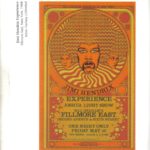 Next came the psychedelic era of the mid- and late 1960s, extending into the very early 1970s. This was the Golden Age of the rock poster and one of the great flowerings of poster art in general. Partly the result of America’s response to the British Invasion, it began in San Francisco and Los Angeles, with such groups as the Charlatans, Country Joe and the Fish, the Byrds, the Doors, and the Grateful Dead. Then it came in a great rush from all other areas of the country. The new music led to a new school of rock poster art, produced in great quantity and received with tremendous enthusiasm. Vivid and imaginative, it stands in dramatic contrast to the art of rock’s earlier period.
Next came the psychedelic era of the mid- and late 1960s, extending into the very early 1970s. This was the Golden Age of the rock poster and one of the great flowerings of poster art in general. Partly the result of America’s response to the British Invasion, it began in San Francisco and Los Angeles, with such groups as the Charlatans, Country Joe and the Fish, the Byrds, the Doors, and the Grateful Dead. Then it came in a great rush from all other areas of the country. The new music led to a new school of rock poster art, produced in great quantity and received with tremendous enthusiasm. Vivid and imaginative, it stands in dramatic contrast to the art of rock’s earlier period.
After the early 1970s, psychedelic music and art —associated with counterculture communities and hippie communes— began to yield to a mainstream increasingly dominated by music industry businessmen. By the mid-1970s, promoting rock was often a corporate rather than a communal endeavor, and the mass-media appeals of newspaper and magazine ads replaced much poster art. What posters did exist displayed a professional maturity and were often effective translations of music into graphic terms. But, like the music itself, the rock poster, now more or less a corporate entity, had lost much of its appealing naiveté.
 Beginning in the late 1970s and continuing in varying degrees into the present, a revolution has been under way, a nove against the mainstream. Punks and new wavers became rock’s cutting edge, and their aggressive sound has been accompanied by a return to street-scorching lamppost art. Unlike psychedelic art, punk and new wave posters aren’t meant to promote inward exploration. Nor are they intended to be displayed on the bedroom or living room wall. They more closely resemble the early rhythm and blues bills and, like them, are meant to be seen outside, on the street. In some purely unconscious way, rock art has thus come full circle.
Beginning in the late 1970s and continuing in varying degrees into the present, a revolution has been under way, a nove against the mainstream. Punks and new wavers became rock’s cutting edge, and their aggressive sound has been accompanied by a return to street-scorching lamppost art. Unlike psychedelic art, punk and new wave posters aren’t meant to promote inward exploration. Nor are they intended to be displayed on the bedroom or living room wall. They more closely resemble the early rhythm and blues bills and, like them, are meant to be seen outside, on the street. In some purely unconscious way, rock art has thus come full circle.
In the early days of the psychedelic scene, póster art was available to even the most casual rock fan. It was for sale in many stores, like the Print Mlnt, the Psychedelic Shop, or Ben Friedman’s Postermat, all in San Francisco. It was also being given away by rock promoters like Bill Graham and by the Family Dog collective, both of whom even sent a póster man around to distribute the posters to head shops, the Berkeley campus, and other likely places. Graham’s posters for his shows at the Fillmore Auditorium and the Family Dog’s posters for theirs at the Avalon Ballroom are especially prized today.
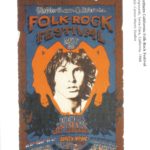 After a time, Bill Graham and the Family Dog promoters could no longer afford to give away the large posters and instead sold them Wholesale to stores, where the usual retail price, up through 1970 or so, was one dollar each.
After a time, Bill Graham and the Family Dog promoters could no longer afford to give away the large posters and instead sold them Wholesale to stores, where the usual retail price, up through 1970 or so, was one dollar each.
The price of rock art has appreciated considerably since the 1960s. Original art —drawings, paintings, artists’ mechanicals (layouts from which posters are made)— now commands a hefty price, and quite a number of rare posters could cost a collector upward of five hundred dollars—even more, if the sale takes place on the East Coast. Fundamentally, however, rock art isn’t «high art»—it isn’t so exalted that it’s out of the reach of even the novice collector.

